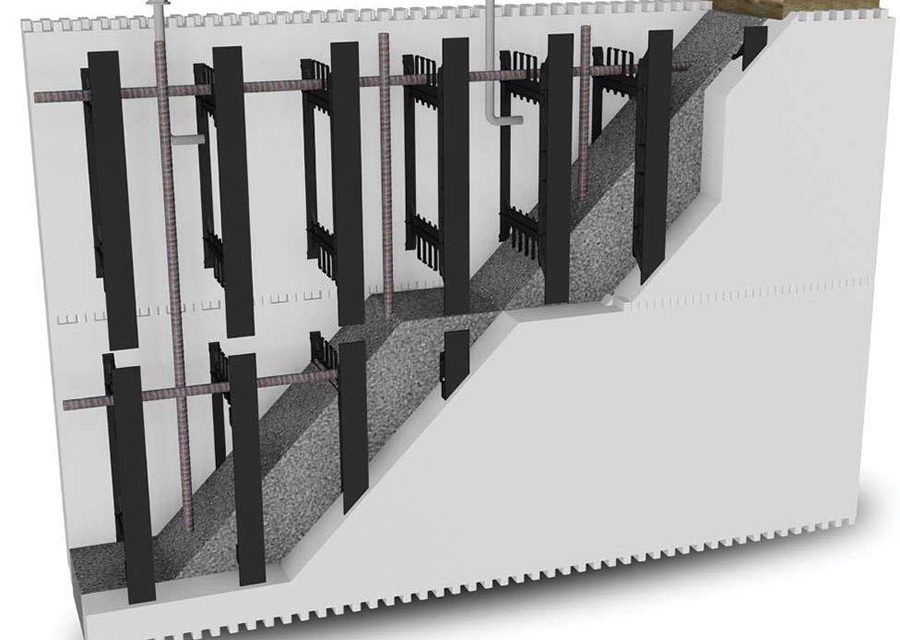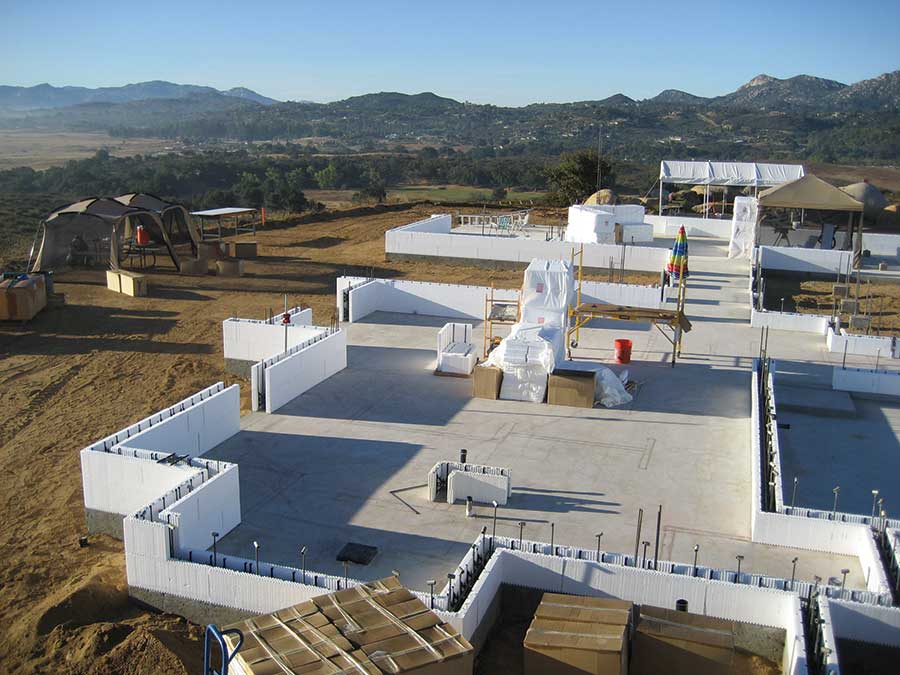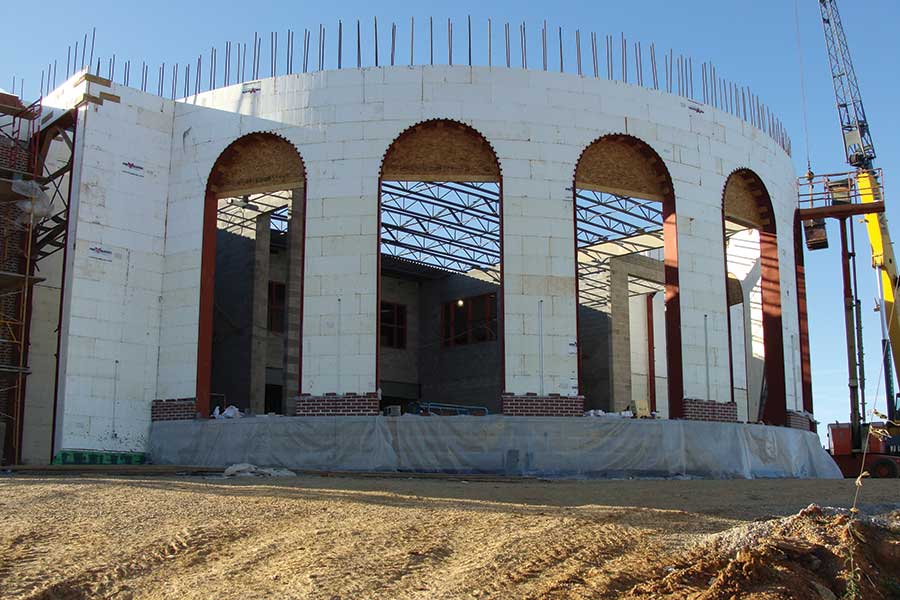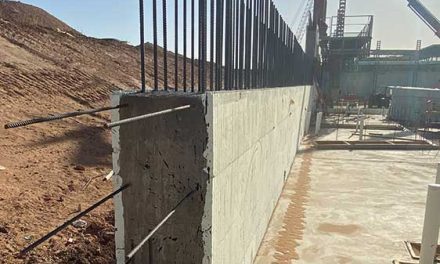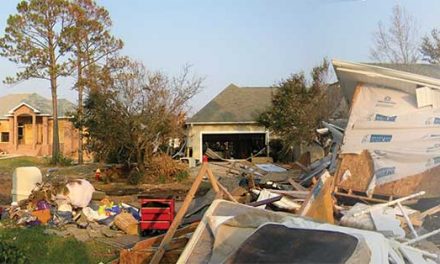An ICF form combines insulation, furring strips, and rebar saddles in a single product.
The number of commercial buildings being built with ICFs has increased dramatically in the past decade. Between 2010 and 2015, the ICF industry has transitioned from being 60% residential to being 60% commercial. Schools, theaters, churches, municipal buildings, and mid-rise apartment complexes are just a few sectors that have seen significant ICF construction.
The growth has been so rapid that it has led to a shortage of experienced and qualified ICF installation subcontractors in many areas of the U.S. and Canada.
David Zirbel is owner of HVB, Inc., one of the largest commercial ICF installers in North America. He reports that he gets calls from general contractors across the country every week asking him to install ICF, but his schedule is already packed. “Just this month I’ve gotten calls from California, Florida, Minnesota, and West Virginia, and I just can’t find the labor,” he says. His crews are booked out for at least two years, despite installing 10,000 to 12,000 sq. ft. of forms per week. Looking to expand, he’s talked to recruiters, temp agencies and trade schools, all of which report that there are simply no available workers. “I ran ads in four major newspapers for a month, offering steady work and competitive pay,” he says. “I received one call.”
ICF installation subcontractors in other areas of the country—Texas, Arizona, and Florida—report similar conditions.
The concern is that as ICF become more popular, the industry will be unable to respond with adequately trained installers. Zirbel reports that his company has been the only bidder on the previous three schools his company has built in West Virginia.
The ICF Manufacturers Association (ICFMA) is working to remedy the situation, and has developed a commercial ICF installation course. It was developed in conjunction with the Mason Contractors Association of America (MCAA) in 2017, and debuted earlier this year at the World of Concrete. Unfortunately, that relationship soon soured as the MCAA membership saw the expansion into ICFs as a conflict of interest.
The National Ready Mix Concrete Association (NRMCA), however, stepped in as a new education partner. ICFMA re-tooled the course and now has at least four presentations planned in upcoming months.
The course is based on the assumption that it’s easier to train a commercial concrete contractor to build with ICFs than it is to train a residential ICF installer the complexities of large-scale commercial work. While the four-hour course cannot cover all the nuances of building with ICFs, it does cover the basics, and provide resources for additional training.
Andy Lennox, chairman of the ICFMA, explains, “This partnership is intended to create a deep pool of commercial ICF contractors across the U.S. that can perform on the ICF projects we see on the horizon. We [ICFMA] underwrite the costs associated with the training, provide the speaker, the product used, etc. NRMCA takes care of the promotion, attendee registration, and so forth.”
The half-day class will be presented in Seattle in late November, in Massachusetts and Connecticut in December, and in Minneapolis in mid-January.
NRMCA is in the midst of a five-year promotional campaign seeking to regain market share in the mid-rise multifamily market, and ICFs play a major part in that effort.
As mentioned earlier, the commercial installation course is intended for concrete contractors familiar with commercial work, but new to ICFs. The four-hour seminar briefly covers the basics of what an ICF is and how it works before delving into the construction basics. The construction section is very similar to the residential “Intro to ICFs” classes offered by most manufacturers.
This presentation does include a segment on commercial floor, ceiling, and wall connections, as well as embed plates. It also covers commercial finishes and utilities, before concluding with basic cost estimates, scheduling, and a list of commercial sectors where ICFs have been especially successful.
A PDF version of the seminar presentation is available through icfmag.com.
Obviously there’s too much information there to be condensed into a brief magazine article. However, the summary below should allow readers to get a feel for the scope of the course.
Part 1. Overview of ICFs
Insulated Concrete Forms are a stay-in-place forming system that consists of two panels of expanded polystyrene (EPS) foam, held together by engineered cross ties—usually made of polypropylene plastic—called webs. Steel reinforcing bars are placed horizontally and vertically in the ICF as the forms are stacked, and then concrete is placed and consolidated in the ICF. The final result is an insulated reinforced concrete wall.
The first ICF system was patented in 1967, but the technology didn’t really gain traction until the 1990s. It took another 10 years before they became popular for commercial applications.
Today, ICFs are sold under a variety of brand names and are widely available across North America. They’re sold through building supply centers, specialty dealers, ready-mix suppliers, and in a few cases, direct from the
manufacturer.
ICFs are incorporated into all U.S. and Canadian building codes, and are suitable for non-combustible wall assemblies. All of the major manufacturers have full product testing, and offer training, engineering support, and estimating software.
Most ICFs are delivered to the jobsite with the cross-ties permanently molded into place. A few ship the cross-ties and foam panels separately. These “knockdown” blocks are more labor intensive to install on the jobsite, but are cheaper to ship and work well for areas with congested rebar.
A variety of specialty forms are also available including corner blocks, taper-tops, brickledges, radius, and Ts.
Part 2. Construction
ICF construction requires a few specialty tools. These include foam guns with low expansion foam canisters, turnbuckle bracing, and a hot knife for cutting utility chases.
Standard strip footings can be used for ICF. Slab-on-grade construction is also common. If step footings are used, vertical increments should be equal to the form height whenever possible.
Material is usually staged inside the wall perimeter, including the ICFs, bracing system, scaffold planks, reinforcing steel, and other miscellaneous materials. Maintaining a seven foot minimum clear inner perimeter between the wall and the staged materials will greatly facilitate setting up the wall alignment system. Production and safety can be greatly improved by maintaining a clean jobsite.
After verifying the layout, start stacking at each corner and work towards the middle. If cuts are necessary, the
units should be cut on the molded lines
to preserve the interlock. If not, a continuous vertical joint is required. This vertical joint requires additional shoring and reinforcement before concrete placement, and experienced installers
place the vertical joint at a window or door opening.
The second level or “course” of forms is placed so the middle of each form overlaps the joint of the row directly
below it. After the second or third level forms are in place, the wall is leveled. Corrections are made by shimming or cutting the forms at the footing. Once the wall is level, one sidewall is secured to the footing using foam or temporary wooden guide boards.
Horizontal reinforcing steel is installed as the wall is stacked, per the engineer’s specifications. Lap splices should follow ACI standards. Particular attention should be paid to lintels. Vertical rebar is installed after all form units are placed. Often, the vertical rebar can be easily woven through the horizontal steel, which helps maintain its proper position within the wall cavity. For multi-story construction, vertical rebar should protrude from the top of the wall by the recommended lap length.
Window and door bucks are placed as the walls are erected. These can be made of dimensioned lumber on site or can be purchased in steel, vinyl, or foam. Additional vertical and horizontal shoring is needed within the buck to withstand the pressures generated by wet concrete. Arched openings can be formed using a variety of methods.
The bracing/alignment/scaffolding system is usually attached when the walls reach four or five courses high. This alignment system should include OSHA-compliant guardrails and fall protection. These braces can be adapted for tall walls or coupled with standard scaffolding for walls higher than 14 feet without intermediate floors.
Service penetrations can be drilled after concrete placement, but many prefer installing sleeves before the concrete is poured.
Part 3. The Concrete Pour
ICF manufacturers provide detailed pre- and post-pour checklists to ensure the most crucial part of the wall construction goes smoothly. Mix design—including strength, slump, and aggregate size—is critical, as is total concrete amount and delivery schedule.
A reducer hose, ram’s horn, or double elbow should be added to the end of the pump boom to help control the concrete fill rate. Walls should be filled in four-foot lifts, and properly vibrated per ACI standards. Lintels, corners, and under window openings are common problem areas and deserve special attention.
Ensure the general schedule allows time for the concrete to reach adequate cure strength before removing bracing or placing loads on the wall.
Part 4. Working with Sub-Trades
Electrical, plumbing and mechanical chases can be cut in with a hot knife, which is cleaner and faster than other methods. Drywall is screwed to the embedded furring strips, which are the interior ends of the form cross ties. A wide variety of exterior finishes can be applied directly to the exterior of an ICF building, including cement, vinyl, steel or wood siding, cement or acrylic stuccos, brick and stone veneer, or any of the numerous curtain wall systems. Because of the concrete core, no additional air barrier is required with ICF construction.
In midrise construction, hollow core precast concrete slabs are popular for flooring. Open web steel joists are also extremely common. Insulated concrete floor systems are also available.
Embed plates and beam pockets are formed and installed during wall erection. Proper concrete consolidation in these areas are will avoid the possibility of honeycombing and voids.
Other connection details, such as ICF-to-CMU, ICF-to-cast in place concrete, deck-to-wall, and roof-to-wall details are available from the ICF manufacturer.
Part 5. Other Details
Gable walls can be formed as an extension of the ICF wall. Specialty radius forms are available for curved walls, or they can be made in the field from straight blocks if sufficient additional reinforcement and bracing is provided.
Taper top forms and brickledge blocks facilitate masonry façades, or any other place a wider concrete bearing surface is required.
Part 6. Cost, Schedule, and the Value Proposition
ICF construction is energy efficient, and tends to be most cost effective when the developer is also the long-term owner. The forms also absorb sound extremely well, and are popular for building types that need to dampen noise within the building. These include multi-screen movie theaters, multifamily construction, the hospitality sector, churches, and schools.
Cost data will vary regionally, based on labor rates, site conditions, and project details such as wall heights, steel requirements, and the number of openings. However, in general, the cost is very competitive with other commercial wall types. Some recent commercial ICF projects cost less than an eight-inch CMU wall when comparable finishes were required. When long-term energy costs are considered, the savings can be significant.

